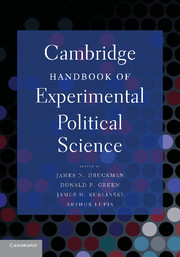Book contents
- Frontmatter
- Contents
- List of Tables
- List of Figures
- Contributors
- Acknowledgments
- INTRODUCTION
- PART I DESIGNING EXPERIMENTS
- PART II THE DEVELOPMENT OF EXPERIMENTS IN POLITICAL SCIENCE
- PART III DECISION MAKING
- PART IV VOTE CHOICE, CANDIDATE EVALUATIONS, AND TURNOUT
- PART V INTERPERSONAL RELATIONS
- 17 Trust and Social Exchange
- 18 An Experimental Approach to Citizen Deliberation
- 19 Social Networks and Political Context
- PART VI IDENTITY, ETHNICITY, AND POLITICS
- PART VII INSTITUTIONS AND BEHAVIOR
- PART VIII ELITE BARGAINING
- PART IX ADVANCED EXPERIMENTAL METHODS
- AFTERWORD
- Name Index
- Subject Index
- References
19 - Social Networks and Political Context
Published online by Cambridge University Press: 05 June 2012
- Frontmatter
- Contents
- List of Tables
- List of Figures
- Contributors
- Acknowledgments
- INTRODUCTION
- PART I DESIGNING EXPERIMENTS
- PART II THE DEVELOPMENT OF EXPERIMENTS IN POLITICAL SCIENCE
- PART III DECISION MAKING
- PART IV VOTE CHOICE, CANDIDATE EVALUATIONS, AND TURNOUT
- PART V INTERPERSONAL RELATIONS
- 17 Trust and Social Exchange
- 18 An Experimental Approach to Citizen Deliberation
- 19 Social Networks and Political Context
- PART VI IDENTITY, ETHNICITY, AND POLITICS
- PART VII INSTITUTIONS AND BEHAVIOR
- PART VIII ELITE BARGAINING
- PART IX ADVANCED EXPERIMENTAL METHODS
- AFTERWORD
- Name Index
- Subject Index
- References
Summary
People are embedded in networks, neighborhoods, and relationships. Understanding the nature of our entanglements and how they shape who we are is fundamental to social sciences. Networks are likely to explain important parts of personal development and contemporary decision making. Researchers have found social networks to be important in activities as disparate as voting (Berelson, Lazarsfeld, and McPhee 1954), immigration patterns (Sanders, Nee, and Sernau 2002), finding a job (Nordenmark 1999), recycling (Tucker 1999), deworming (Miguel and Kremer 2004), cardiovascular disease and mortality (Kawachi et al. 1996), writing legislation (Caldeira and Patterson 1987), and even happiness (Fowler and Christakis 2008). A wide range of political outcomes could be studied using social networks; the only limitation is that the outcome be measurable. Ironically, the very ubiquity and importance of social networks make them difficult to study. Isolating causal effects is always difficult, but when like-minded individuals cluster together, share material incentives, are exposed to common external stimuli, and simultaneously influence each other, the job of reliably estimating the importance of social ties becomes nearly impossible. Rather than offering a comprehensive overview of the wide number of topics covered by social networks, this chapter focuses on the common empirical challenges faced by studies of social networks by considering the challenges faced by observational studies of social networks, discussing laboratory approaches to networks, and describing how network experiments are conducted in the field. The chapter concludes by summarizing the strengths and weaknesses of the different approaches and considers directions for future work.
- Type
- Chapter
- Information
- Cambridge Handbook of Experimental Political Science , pp. 273 - 286Publisher: Cambridge University PressPrint publication year: 2011
References
- 4
- Cited by



